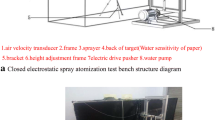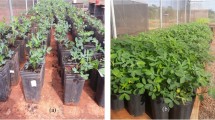Abstract
Research in precision spraying investigates the means to reduce the amount of herbicide applied by directing droplets more accurately towards the weeds. The trend in the development of spot spraying equipment is an increase of the spatial resolution and new actuators that are able to target very small areas. However, there is a lack of methods for assigning rates of herbicides relating target to optimal droplet features. A wide range of droplet impact angles occurs during the spray application process because of droplet trajectories and the variability of leaf orientation. In this study, laboratory experiments were conducted to highlight the effect of surface orientation on droplet impact outcomes (adhesion, rebound or splashing) on two very difficult-to-wet surfaces: an artificial surface with a regular roughness pattern and an excised black-grass leaf with an anisotropic roughness pattern. Measurements were performed for different surface orientations with a high-speed camera coupled with backlighting LED. Droplets of two formulations (distilled water and distilled water + a surfactant) were produced with a moving flat-fan hydraulic nozzle to obtain a wide range of droplet sizes and velocities, which were measured by image analysis. Increasing surface angle reduces surface area available for droplet capture. Droplet impact behaviors are then modified since surface tilt induces a tangential velocity component at impact and, consequently, a reduction of the normal component. Impact modifications have also been observed due to the anisotropic roughness pattern of a black-grass leaf. The integration of droplet-surface interaction information offers a significant way to further improve the precision spraying efficiency by considering the optimal droplet size, speed and ejection angle depending on the target surface and architecture.




Similar content being viewed by others
References
Baetens, K., Nuyttens, D., Verboven, P., De Schampheleire, M., Nicolaï, B., & Ramon, H. (2007). Predicting drift from field spraying by means of a 3D computational fluid dynamics model. Computers and Electronics in Agriculture, 56(2), 161–173.
Barthlott, W., Neinhuis, C., Cutler, D., Ditsch, F., Meusel, I., Theisen, I., et al. (1998). Classification and terminology of plant epicuticular waxes. Botanical Journal of the Linnean Society, 126(3), 237–260.
Bird, J. C., Scott, S. H., Tsai, S. S. H., & Stone, H. A. (2009). Inclined to splash: triggering and inhibiting a splash with tangential velocity. New Journal of Physics, 11, 063017.
Butler Ellis, M. C., & Miller, P. C. H. (2010). The Silsoe Spray Drift Model: A model of spray drift for the assessment of non-target exposures to pesticides. Biosystems Engineering, 107(3), 169–177.
Butler Ellis, M. C., Webb, D. A., & Western, N. M. (2004). The effect of different spray liquids on the foliar retention of agricultural sprays by wheat plants in a canopy. Pest Management Science, 60(8), 786–794.
Callies, M., & Quere, D. (2005). On water repellency. Soft Matter, 1(1), 55–61.
Cassie, A. B. D., & Baxter, S. (1944). Wettability of porous surfaces. Transactions of the Faraday Society, 40, 546–551.
Furmidge, C. G. L. (1962). Physico-chemical studies on agricultural sprays. IV.—The retention of spray liquids on leaf surfaces. Journal of the Science of Food and Agriculture, 13(2), 127–140.
Gaskin, R. E., Steele, K. D., & Forster, W. A. (2005). Characterising plant surfaces for spray adhesion and retention. New Zealand Plant Protection, 58, 179–183.
Ghosh, S., & Hunt, J. C. R. (1998). Spray jets in a cross-flow. Journal of Fluid Mechanics, 365, 109–136.
Giles, D. K., Slaughter, D. C., & Upadhyaya, S. K. (2002). Biological target sensing and sprayer control. Aspect of Applied Biology, 66, 129–138.
Holterman, H. J., van de Zande, J. C., Porskamp, H. A. J., & Huijsmans, J. F. M. (1997). Modelling spray drift from boom sprayers. Computers and Electronics in Agriculture, 19(1), 1–22.
Jensen, P. K. (2012). Increasing efficacy of graminicides with a forward angled spray. Crop Protection, 32, 17–23.
Journaux, L., Simon, J. C., Destain, M. F., Cointault, F., Miteran, J., & Piron, A. (2011). Plant leaf roughness analysis by texture classification with generalized Fourier descriptors in a dimensionality reduction context. Precision Agriculture, 12(3), 345–360.
Knoche, M. (1994). Effect of droplet size and carrier volume on performance of foliage-applied herbicides. Crop Protection, 13(3), 163–178.
Lake, J. R., & Marchant, J. A. (1983). The use of dimensional analysis in a study of drop retention on barley. Pesticide Science, 14(6), 638–644.
Lecuona, A., Sosa, P. A., Rodríguez, P. A., & Zequeira, R. I. (2000). Volumetric characterization of dispersed two-phase flows by digital image analysis. Measurement Science & Technology, 11(8), 1152–1161.
Lee, W. S., Slaughter, D. C., & Giles, D. K. (1999). Robotic Weed Control System for Tomatoes. Precision Agriculture, 1(1), 95–113.
Massinon, M., & Lebeau, F. (2012a). Comparison of spray retention on synthetic superhydrophobic surface with retention on outdoor grown wheat leaves. Aspect of Applied Biology, 114, 261–268.
Massinon, M., & Lebeau, F. (2012b). Experimental method for the assessment of agricultural spray retention based on high-speed imaging of drop impact on a synthetic superhydrophobic surface. Biosystems Engineering, 112(1), 56–64.
Massinon, M., & Lebeau, F. (2013). Review of physicochemical processes involved in agrochemical spray retention. Biotechnology, Agronomy, Society and Environment, 17(3), 494–504.
Matthews, G. (2008). Pesticide Application Methods (3rd ed.). Oxford: Blackwell.
Miller, P., Tillett, N., Hague, T., & Lane, A. (2012a). The development and field evaluation of a system for the spot treatment of volunteer potatoes in vegetable crops. Aspect of Applied Biology, 112, 113–120.
Miller, P., Tillett, N., Swan, T., Tuck, C., & Lane, A. (2012b). The development and evaluation of nozzle systems for use in targeted spot spraying applications. Aspect of Applied Biology, 114, 159–166.
Mokeba, M. L., Salt, D. W., Lee, B. E., & Ford, M. G. (1997). Simulating the dynamics of spray droplets in the atmosphere using ballistic and random-walk models combined. Journal of Wind Engineering and Industrial Aerodynamics, 67–68, 923–933.
Mundo, C., Sommerfeld, M., & Tropea, C. (1995). Droplet-wall collisions: Experimental studies of the deformation and breakup process. International Journal of Multiphase Flow, 21(2), 151–173.
Nieuwenhuizen, A. T., Hofstee, J. W., & Henten, E. J. (2010). Adaptive detection of volunteer potato plants in sugar beet fields. Precision Agriculture, 11(5), 433–447.
Quéré, D. (2005). Non-sticking drops. Reports on Progress in Physics, 68(11), 2495–2532.
Reichard, D. L., Cooper, J. A., Bukovac, M. J., & Fox, R. D. (1998). Using a videographic system to assess spray droplet impaction and reflection from leaf and artificial surfaces. Pesticide Science, 53(4), 291–299.
Rein, M. (1993). Phenomena of liquid drop impact on solid and liquid surfaces. Fluid Dynamics Research, 12(2), 61–93.
Rioboo, R., Voué, M., Vaillant, A., & De Coninck, J. (2008). Drop Impact on Porous Superhydrophobic Polymer Surfaces. Langmuir, 24(24), 14074–14077.
Šikalo, Š., Tropea, C., & Ganić, E. N. (2005). Impact of droplets onto inclined surfaces. Journal of Colloid and Interface Science, 286(2), 661–669.
Søgaard, H. T., & Lund, I. (2007). Application Accuracy of a Machine Vision-controlled Robotic Micro-dosing System. Biosystems Engineering, 96(3), 315–322.
Stow, C. D., & Hadfield, M. G. (1981). An Experimental Investigation of Fluid Flow Resulting from the Impact of a Water Drop with an Unyielding Dry Surface. Proceedings of the Royal Society of London. Series A, Mathematical and Physical Sciences, 373, 419–441.
Taylor, P. (2011). The wetting of leaf surfaces. Current Opinion in Colloid & Interface Science, 16(4), 326–334.
Tellaeche, A., BurgosArtizzu, X. P., Pajares, G., Ribeiro, A., & Fernández-Quintanilla, C. (2008). A new vision-based approach to differential spraying in precision agriculture. Computers and Electronics in Agriculture, 60(2), 144–155.
Thorp, K. R., & Tian, L. F. (2004). A review on remote sensing of weeds in agriculture. Precision Agriculture, 5(5), 477–508.
Tsai, P., Hendrix, M. H. W., Dijkstra, R. R. M., Shui, L., & Lohse, D. (2011). Microscopic structure influencing macroscopic splash at high Weber number. Soft Matter, 7(24), 11325–11333.
Venzmer, J. (2011). Superspreading: 20 years of physicochemical research. Current Opinion in Colloid & Interface Science, 16(4), 335–343.
Walklate, P. J. (1987). A random-walk model for dispersion of heavy particles in turbulent air flow. Boundary-Layer Meteorology, 39(1–2), 175–190.
Wenzel, R. (1936). Resistance of solid surface to wetting by water. Industrial and Engineering Chemistry, 28(8), 988–994.
Wirth, W., Storp, S., & Jacobsen, W. (1991). Mechanisms controlling leaf retention of agricultural spray solutions. Pesticide Science, 33(4), 411–420.
Yarin, A. L. (2006). Drop impact dynamics: Splashing, spreading, receding, bouncing…. Annual Review of Fluid Mechanics, 38, 159–192.
Zabkiewicz, J. A. (2007). Spray formulation efficacy: Holistic and futuristic perspectives. Crop Protection, 26(3), 312–319.
Zhao, Y., Lu, Q., Li, M., & Li, X. (2007). Anisotropic wetting characteristics on submicrometer-scale periodic grooved surface. Langmuir, 23(11), 6212–6217.
Zu, Y. Q., Yan, Y. Y., Li, J. Q., & Han, Z. W. (2010). Wetting behaviours of a single droplet on biomimetic micro structured surfaces. Journal of Bionic Engineering, 7(2), 191–198.
Acknowledgments
This research was funded by Service Public Wallonie DG06 (Belgium) in the framework of the EUREKA (http://www.eurekanetwork.org/) project 4984 VEGEPHY.
Author information
Authors and Affiliations
Corresponding author
Rights and permissions
About this article
Cite this article
Massinon, M., Boukhalfa, H. & Lebeau, F. The effect of surface orientation on spray retention. Precision Agric 15, 241–254 (2014). https://doi.org/10.1007/s11119-013-9345-2
Published:
Issue Date:
DOI: https://doi.org/10.1007/s11119-013-9345-2




